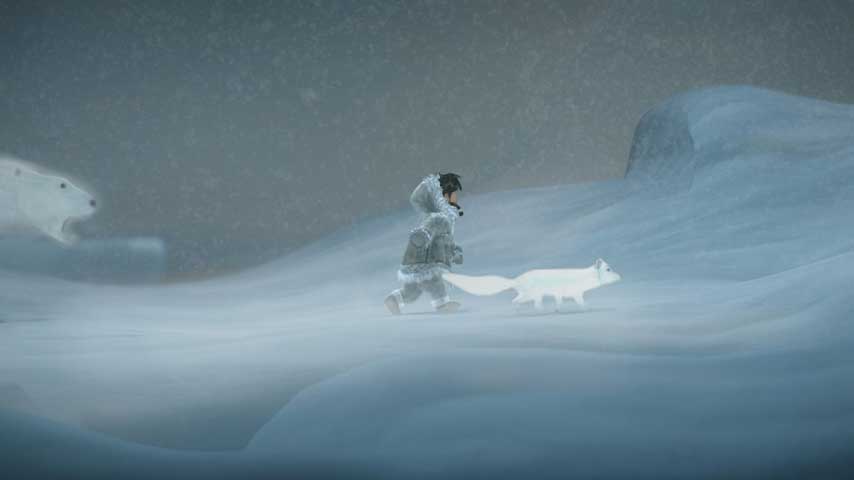Probably the best game based around the Iñupiat people of Alaska that you’ll play this year…probably.
Never Alone is an important and encouraging sign for video gaming as an art-form. Developed in collaboration with the Iñupiat, an Alaska Native people, Never Alone retells and reimagines several Iñupiat stories. Told through the eyes of Nuna, a young girl struggling to end an eternal blizzard threatening her home, with the help of an arctic fox who serves as her companion and protector. Whilst this endless blizzard is the central story, other tales are worked into the plot as Nuna makes her way through the harsh, arctic environment.
Never Alone is short. Like really short. Imagine if Danny Devito was a video game; it’s that short. I completed the game in about 3 hours, and by completed I mean 1000G, all collectibles, everything the game has to offer completed. Never mind that though, quality over quantity right? Eh.

The gameplay is your typical puzzle platformer with the player controlling Nuna and Fox, switching between the two as the need arises. Each character has their own unique abilities which must be used to progress through the puzzles. Nuna can push boxes and throw a Bolas to destroy obstacles, whilst the fox can fit through tight gaps and scramble up walls. The puzzles are very basic, so don’t come here looking for a challenge.
It’s all very reminiscent of Max: The Curse of Brotherhood; simple platforming and puzzles solved by switching control of your character, but this time replace the magic marker with a magic fox. There is also a hefty sprinkling of Brothers: A Tale of Two Sons in here too, mostly in the way emotional weight is added without dialogue. Unfortunately, Never Alone doesn’t handle these concepts with the same level of finesse as its predecessors. The puzzles really offers no challenge, even in the later stages and attempts to tug at the heart strings fall fairly flat as well.
Spoiler alert, the next paragraph contains plot details so only read it if you don’t care about spoilers. Last warning…

I would have bet a lot of money coming into this game that one of the characters died and of course, I’d have been a very rich man. It’s a very tired trope in indie games at the moment, maybe a sad indictment that there really isn’t much more imagination in the indie scene than AAA games after all. Never Alone doesn’t even stick to its guns on this one though, because about 10 seconds after the character dies, they are magically reborn. It may be part of an Iñupiat legend and that’s fine, but it makes for a fairly predictable and, at the same time, disappointing event. This is a tale of hardship, loss and sacrifice, but none of those things happen.
The level design has to be commended for keeping things fresh, with each level bringing a new environment and new challenges to overcome. One level will have you manipulating branches in a forest to climb trees, and the next will see you fleeing from a polar bear over cracked sea ice. You won’t find yourself repeating the same tricks too often, a trap too many games fall into.
Never Alone is beautiful to look at, conveying the harsh, desolate beauty of an arctic environment quite masterfully. It’s very white, as you’d expect, but each level manages to differ from the previous just enough. Combine this with a simplistic but fitting musical style and Never Alone really nails down the themes it was shooting for.

I mentioned collectibles earlier and they are one of the cooler features in Never Alone. Called Cultural Insights, these videos are interviews with the developers and Iñupiat people who worked on the game as they discuss the legends and stories that were the inspiration for Never Alone. These videos are probably the best part of the whole game, giving a real insight into the Iñupiat people in a way the gameplay itself falls short of. Sadly these collectibles aren’t much fun to go out and find. Almost all of them are on the path you’ll follow to the end of the level, and those few that are off the beaten track are still painfully obvious.
Never Alone accomplishes everything it set out to do, and as an interactive lesson on the Iñupiat people it scores top marks. Schools should snap up the chance to use this title in the classroom, but unless you’re interested in the history and legends of the Alaskan people, I really can’t recommend this as a game. It just isn’t very fun. Maybe this is why games can’t be art in some people’s eyes; art doesn’t have to be enjoyable to be great, but I still feel a video game does.